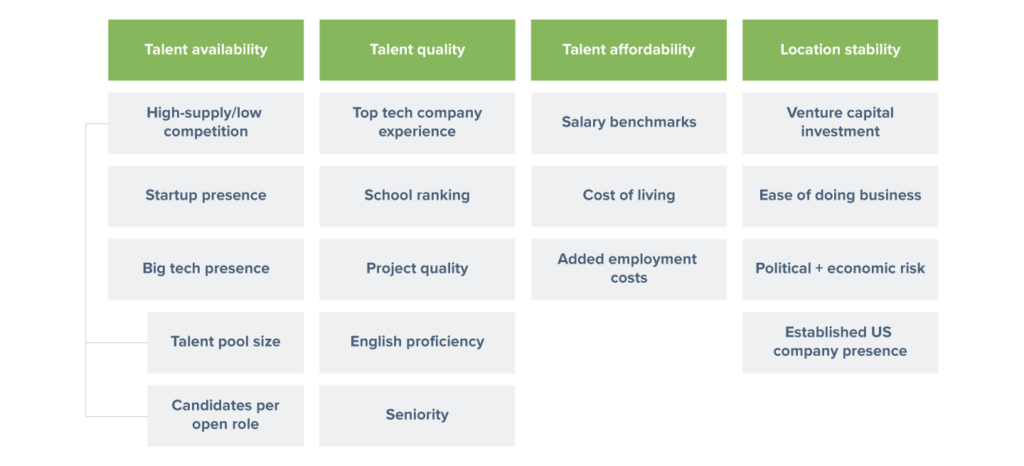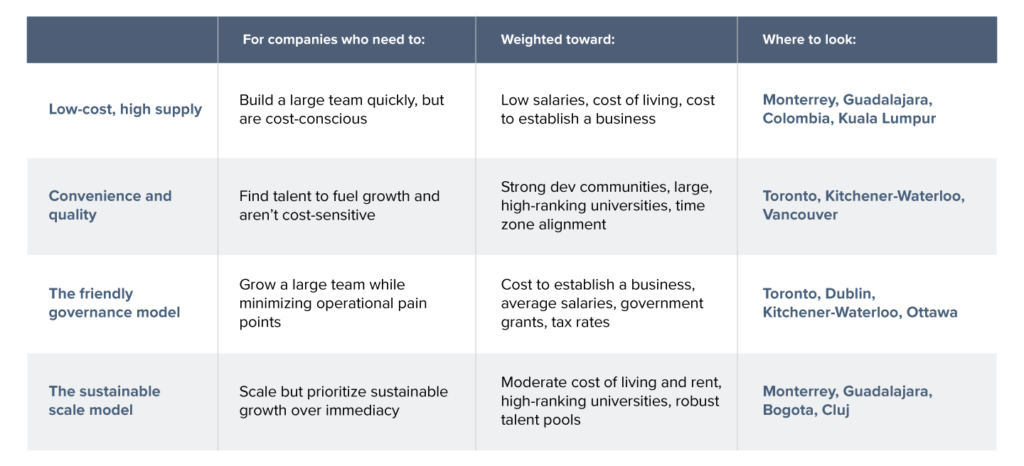
Talent markets | Blog Post
Global recruiting 101: Selecting the right talent market
Linzi Nield
Share this post
As we transition to a recruiting environment where technical talent can be sourced around the globe, a key question has emerged: Are organizational leaders ready to recruit globally?
It turns out, many are not. From our recent remote leadership study, we found that just 35% of leaders have made a hire in another country, and 1 in 5 leaders don’t have a global recruiting strategy.
Many HR leaders have yet to harness the global recruiting skillset and are instead relying on talent sourcing around traditional brick and mortar headquarters, which means they are missing out on pools of stellar (and affordable) talent around the world.
In today’s remote era, elite engineering talent is available around the globe and a mix of factors are bolstering the remote talent economy like never before; new incredible engineering schools are popping up globally, governments are implementing stronger policies around tech growth, and STEM education programs are becoming increasingly prevalent. For all these reasons, in 2020 a global workforce may add up to being stronger than a local one.
There’s never been a better time to learn how to exercise this powerful muscle of global talent recruiting, and we’re here to help you understand how.
Selecting the right talent markets
One of the first and most essential steps for creating an impactful global recruiting strategy is to begin by making sure you’re selecting the right global talent market to search within.
This requires gaining a very clear picture of the candidate profile your company is seeking, and then doing the necessary research to find the global talent markets that best align with these needs. At Terminal we call this practice market mapping.
Global talent markets are constantly evolving due to changing market forces, such as access to local degree programs and shifting business and trade regulations. For hiring managers and engineering leaders, it’s critical to understand these many factors as they begin honing in on potential markets.
This is why two prominent cornerstones of effective market selection include first understanding the most essential criteria of a market and its talent that are a priority to your organization, and then gaining the deeper data perspective on the local talent market.
Market selection: What to consider for your business
Exploring any new market means your organization needs to think through a long list of variables. You can start this process as an organization by first asking questions that will help you think through your internal hiring needs and deepen your understanding:
- What are your growth needs? Do you need just a few developers or is there a need to scale?
- What are the criteria that matter most to your organization? Do you value talent quality or quantity, or a balance of both?
- What “convenience” factors would make your team more successful, such as time zone alignment?
With this bigger picture of your needs, your organization can then begin researching which markets might meet your criteria.
Below is an example of our “core four” talent market criteria, which are areas that will either make or break our decision to enter a new market, including:
- Talent availability: This relates to the overall supply and availability of local talent (metrics include talent pool size and number of candidates per open role), in addition to the volume of local startups and big tech firms that have a local presence.
- Talent affordability: Important factors to consider here include local cost of living, researching added local employee costs, and local salary benchmarks.
- Talent quality: Local university rankings, English language proficiency, number of candidates with experience working in big tech, and volume of senior candidates—there are many elements that go into this part of the equation.
- Location stability: For this area we seek to understand the ease of doing business locally, including local political and economic risk, assess the presence of established US companies doing business in the market, and understand the volume of local VC investment, and whether they have been growing year-over-year.

Accessing data like this can be an onerous task. At Terminal we conduct deep research and market analysis on an ongoing basis across 60+ emerging talent markets worldwide – look to partner with organizations like us or market analysts who have a deep knowledge of these markets already and can quickly help you narrow down the list.
Four types of global hiring models to consider
From our extensive research into remote hiring, we’ve categorized four primary types of global hiring models that we often see organizations fall into, each which addresses specific goals and outcomes for global recruiting, and can appeal to different employers at varying stages of growth.
Model 1, Low-cost, high-supply:
Weighted toward: Low salaries, rent, cost of living, and cost to establish a business.
For companies looking to build a large team quickly, with cost-consciousness as a major consideration, this model points you to markets with a large talent pool and low cost of living. While you may sacrifice developer experience in some locations, you’ll see decreased costs associated with launching. Just make sure you plan to provide your own training early on to build up talent.
Model 2, Convenience and quality:
Weighted toward: Strong developer communities, high-ranking universities with large student populations, government support for tech and low travel time to HQ.
For growth-stage companies needing seasoned talent who aren’t particularly cost-sensitive, this model places access to talent and ease of establishing business over market cost. It alleviates some of the training needs and can result in faster integrations with the team at HQ.
Model 3, The friendly governance model:
Weighted toward: cost to establish a new business, average software engineer salary, government grants, tax rates.
For large companies concerned with the ease of doing business locally as well as avoiding future roadblocks to growth, this model looks at cities that are supportive to tech – while balancing some cost-conscious measures to expedite growth.
Model 4, The sustainable scale model (hybrid evaluation):
Weighted toward: Moderate cost of living and rent, high-ranking universities, rank to establish a business and robust talent pool.
For companies looking for sustainable scale over immediacy, and moderate cost-consciousness, this model focuses on the best of all location attributes, balancing cost, quality, and ease of establishing a business with a substantial talent pool.

New market analysis: Your best first step
In today’s rapidly shifting workforce, it’s important more than ever to get a head start on building a global recruiting strategy.
And, while you may hear about emerging tech talent hot spots by word of mouth, make sure your organization takes a strategic approach to remote hiring by first doing deep market analysis into your considered markets.


